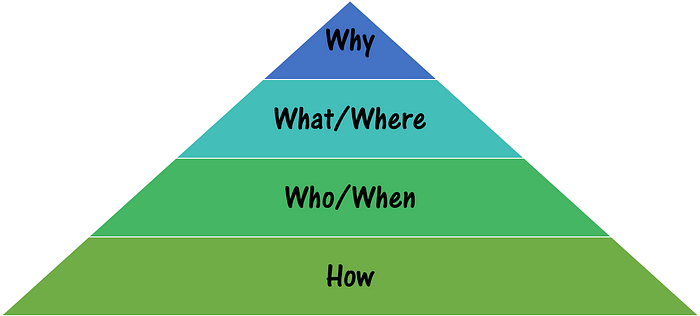Four Levels of Leadership Questions: Elevate Your Leadership Mindset
The types of questions you ask are a reflection of your leadership vantage points
Leadership growth starts with reflection—specifically, on the types of questions you ask. Do you focus on HOW—execution and efficiency—or do you challenge the WHY—purpose and impact? The questions you prioritize shape your trajectory, whether in the corporate world or beyond.
Using a building as an analogy, leadership inquiry shifts as you ascend levels:
Level 1: Ground Floor (Individual Contributors) – HOW?
At this level, visibility is limited. You’re focused on tasks: how to get things done, how to meet deadlines, how to build relationships, how to get promoted. The assumption is that the work must be completed—it’s already been decided and handed down. Success here often comes from technical expertise, earning recognition for execution and becoming the go-to SME.
Level 2: Mid-Level (Frontline Managers & Middle Management) – WHO & WHEN?
Now, responsibility expands to delegation. You work within predetermined objectives, assigning tasks to team members with the right skills and capacity. You negotiate who does what and when it gets done. Stakeholder management and direct relationships are key, ensuring delivery while maintaining team engagement. Decisions are tactical rather than strategic.
Level 3: High Rise (Middle & Upper Management) – WHAT & WHERE?
The focus shifts toward organizational goals. You define what needs to be done to align with strategic priorities and where resources should be allocated. Leadership at this level means leading initiatives, structuring teams, and securing resources. Those who thrive here often advance quickly, gaining visibility through their ability to translate strategy into execution.
Level 4: Rooftop (Executive Leadership) – WHY & SO WHAT?
At the highest level, visibility is at its peak—but details of execution fade. Instead, you shape purpose, impact, and long-term direction. You’re responsible for answering why the organization exists and the so what—its broader influence on society. Decisions at this level are steeped in uncertainty, values, and risk tolerance.
Crucially, leadership here isn’t just about what to do—it’s about what to say NO to. It’s easy to add priorities; far harder to subtract them. Limited time, resources, and focus demand ruthless prioritization. Until you’re willing to let go of non-essential tasks, you can’t fully devote yourself to what truly matters.
While we all move across different levels throughout our careers, we may spend more time in certain phases without realizing it. Entrepreneurs constantly shift between them, trading certainty for excitement and the potential for outsized success. Corporate professionals may remain fixed at a particular level, sometimes unconsciously.
Leadership isn’t just about moving up—it’s about knowing where you are, recognizing when you’re stuck, and being intentional about where you want to go. If you find yourself asking mostly HOW questions, are you seeking efficiency or missing bigger strategic opportunities? If you ask WHY often, are you refining vision or struggling with ambiguity?
The key isn’t to chase a higher floor—it’s to ensure you’re asking the right questions for the impact you want to make.
So, where do you find yourself most often? And is it where you want to be?




